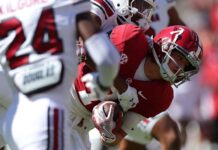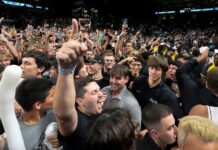[ad_1]
LAS VEGAS – NCAA President Charlie Baker said the settlement of the association’s pending antitrust lawsuit will put a financial strain on everyone in the college sports industry, but he believes it creates more certainty for schools to plan a new system that will further divide them. will allow money with their athletes.
The NCAA announced last month that it had agreed to terms to settle three federal antitrust lawsuits that have emerged as the most immediate and arguably the biggest threat to the association’s future. As part of the settlement, the NCAA will pay former athletes nearly $2.8 billion in back damages. In addition, schools would be allowed to share a significant portion of the revenue — about $20 million per year through 2025 — directly with their athletes. In exchange, the plaintiffs agreed to drop three cases that some in college sports believe could total nearly $20 billion in damages.
“There’s a lot of pressure on everybody,” Baker said. “I think that’s a lot better than the stress of what could be catastrophic damage. It would have taken a few more years. So, we’re going to be spinning our wheels for a few more years not really knowing what’s going to happen.”
Baker, in his first extensive interview since agreeing to a settlement, told reporters he hopes the terms of the settlement will establish a way for schools to compensate their athletes fairly without turning them into employees.
The NCAA remains a defendant in multiple lawsuits that argue that college athletes should be treated as employees of their schools or conferences. While the settlement doesn’t address those issues, Baker and others in college sports hope that future plans to share revenue with athletes will encourage Congress to write a new law that would prevent athletes from becoming employees.
“If the court blesses (the pending settlement), it puts us in a position where we can go to Congress and say: ‘One of the three branches of the federal government has blessed this as a model for creating compensation without employment,'” Baker said Monday. “I think that’s a good place to start the conversation with Congress.”
NCAA and conference leaders have made little progress over the past few years lobbying politicians on Capitol Hill for a new law that would create a special status for college sports as an industry. Baker said he has heard positive feedback from several federal lawmakers since the terms of the settlement were disclosed.
At a conference for athletic directors in Las Vegas this week, Baker said he was questioned about how some details of the settlement could affect the future shape of college sports. He said more answers could come in the next 30 days, when lawyers for both sides of the antitrust case are expected to submit the fine-print details of their settlement to the court.
The detailed terms of the settlement must still be approved by the federal judge overseeing the cases — a process that could take months and includes a window for athletes to object or comment on the terms.
“I’m a little uneasy about going much further than that,” Baker said. “People are starting to think about how to plan for it. We certainly are. But we fully recognize and understand that there are a bunch of things that have to happen before the thing becomes official.”
Some legal experts questioned whether the judge in this case would take issue with a class-action settlement that would make it harder for athletes to sue the NCAA for antitrust violations in the future. Asked if he had concerns about the settlement being approved, Baker said the case has involved central figures on all sides of the argument for compensating college athletes over the past 10 years.
“If you think fielders are important, we’ve got most of them,” he said.
Two of the biggest pending questions for school officials preparing for a new business model concern the role that Title IX laws and booster collectives will play in how revenue is shared with athletes in the future.
Title IX regulations require schools to provide equal benefits and opportunities to men and women for their varsity sports on campus. The Education Department, which oversees Title IX on college campuses, has not commented on whether schools must split athletic funding equally between men and women to comply with the law.
“I’m going to wait and see where the dust settles (on the settlement) before we engage in that conversation,” Baker said. “The one thing we should do here is not race. We should be intentional and trust the process here.”
Multiple sources told ESPN that part of the settlement is aimed at reining in conglomerates — groups of boosters tied to a particular school that have served as de facto salaries in some places as the NIL market has evolved over the past three years. Baker said he doesn’t believe the collectives are disappearing as a result of the settlement, but he hopes the new revenue-sharing arrangement will make it easier for schools to “own the primary relationship” with their athletes.
The NCAA plans to pay $2.8 billion in back damages over the course of the next 10 years. Baker said at least $120 million (or about 42%) of the annual payment for the settlement would come from the NCAA’s national office budget. Another 58% reduced the amount of money that the NCAA typically distributes among its members — 33% from FBS schools, 13% from FCS schools and 12% from Division I schools that do not have football programs.
Some minor league athletic directors and conference officials have raised concerns about the amount of money lost over the next 10 years from the NCAA’s distribution to power conferences that make the most money from football. . Baker said the back-to-back losses are related to a set of rules that the entire NCAA membership — including schools from those smaller conferences — approves and maintains.
Baker also said he thinks the settlement’s 10-year gap will serve as “glue” to help bind the larger group of Division I schools together, avoiding the possibility of the conference having the power to form a separate entity with its own rules. Keeping all of Division I together would allow the NCAA to maintain the March Madness basketball tournament that generates the bulk of the money the association distributes to its schools.
“We now have the ability to move forward with the assumption that we’re all one big, maybe happy, family moving forward,” Baker said.
Baker said the NCAA’s national office has pledged to potentially increase its contribution to more than $120 million in compensation if revenue for the national tournaments it hosts increases.
[ad_2]











